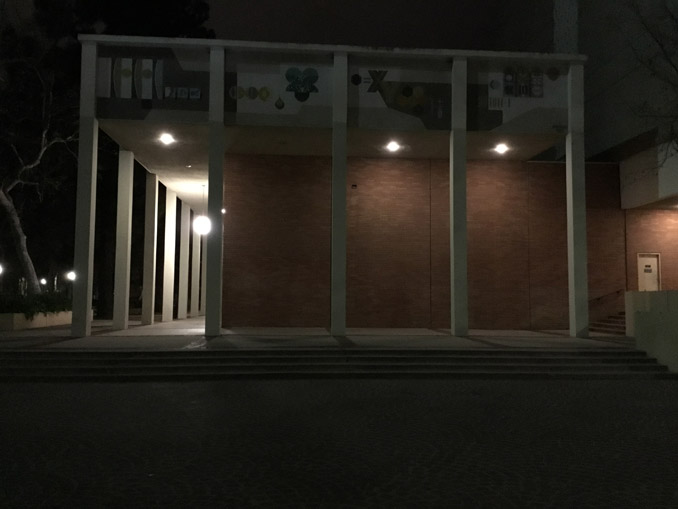The Apple iPad Pro Review
by Ryan Smith, Joshua Ho & Brandon Chester on January 22, 2016 8:10 AM ESTCamera
While it’s pretty much a universally terrible idea to use a tablet as your primary camera, for something like video chat or in an emergency it’s better to have one than not. In the case of the iPad Pro, the camera is essentially identical to what we saw with the iPad Air 2, which is to say an 8MP 1.1 micron 1/4” sensor, with an F/2.4 aperture and 3.3mm focal length, which translates to a 35mm equivalent focal length of 31mm. There’s no PDAF or anything fancy going on here, so it’s pretty much a guarantee that the camera is the exact same module that we saw with the iPad Air 2. The front facing camera is still a 1.3MP F/2.2 2.65mm focal length module, which leads me to believe that it too is shared with the iPad Air 2. I honestly don’t see any difference between the iPad Air 2 and iPad Pro cameras, so rather than spending time dwelling on those this comparison will be focused upon how it compares to popular smartphones and the tablet competition. As I don’t have a tripod mount that can actually fit the iPad Pro, I’ve elected to forgo some of our standard latency tests to avoid presenting data with confounding variables.
| Daytime Photography Scene 1 |
In our first daytime scene the iPad Pro is actually not that far off from the iPhone 6s. If you look closely it’s obvious that there is less detail to be seen, but it’s honestly quite difficult to see the difference. Relative to the iPhone 6, detail is almost identical. For a camera that should basically be never used for the kinds of photos I’m taking for this review, the camera will work well in a pinch. By comparison the Pixel C is rather disappointing. Even in this ideal condition, detail is visibly worse when compared to the iPad Pro. I’m not sure whether this poor showing is caused by camera shake or AF issues but in general the AF system for the Pixel C had some pretty noticeable issues in general. There are also some obvious problems with color noise despite base ISO, which is shocking.
| Daytime Photography Scene 2 |
In the interest of trying to collect more than one data point for presentation in the review, I tried another scene. Once again, the iPhone 6s shows a minor resolution lead and the iPad Pro is pretty close to the iPhone 6 here. By comparison while there isn’t any obvious weirdness going on the Pixel C clearly has less detail and a noticeable amount of color noise, which is surprising even for a tablet camera. Color noise is one of the most distracting things in any photo, so I’m always concerned when any mobile device has a camera where the JPEG output shows color noise.
| Low Light Photography Scene 1 |
| Low Light Photography Scene 2 |
Moving on to the low light testing, we clearly see the disadvantage that comes with smaller pixel sizes. The iPad Pro is just clearly worse than the iPhone 6 and 6s here. The 6s Plus is the clear winner of this test. While the iPad Pro has dark output, it’s miles better than the Pixel C and Nexus 9, both of which show enormous amounts of color noise. The Tegra X1 and K1 ISP for whatever reason is struggles with doing things like hot pixel compensation in low light, as in the dark areas of the photo there are obvious bright speckles of pixel noise.
| Low Light Photography Scene 3 |
In another low light scene we see the same sort of ordering that was in the previous scene. The iPad Pro is acceptable here, but the iPhone 6, 6s, and 6s Plus are all clearly superior. However, the iPad Pro is clearly superior to the Pixel C and Nexus 9 on the basis of better detail and noise reduction. Unlike most smartphones I don’t really see a huge difference in how well everything freezes motion here, but I suspect this might just be because the entire image for the Pixel C and Nexus 9 is so lacking in detail.
Video
| 1080p30 Video |
Looking at video performance, the iPad Pro noticeably lags behind the iPhone in feature set, which isn't entirely unsurprising given that the camera on any tablet should be strictly reserved as a fallback for when you can’t get to a smartphone or literally anything else. 1080p30 is encoded with H.264 high profile at 17 Mbps, with around 82 Kbps single channel AAC audio. For the most part, quality here is actually comparable to the iPhone 6 and 6s in daytime, with a noticeably tighter crop due to the longer 35mm equivalent focal length. The iPhone 6s Plus is again the obvious winner here though, due to its use of OIS in video. By comparison, the Pixel C shows clearly less detail, and the higher contrast leads to worse detail in areas like the road and in shadows.
| Slow-Motion Video |
In 720p120, the iPad Pro is clearly worse than the iPhone 6s and 6s Plus just by virtue of not supporting 1080p here. That's not exactly surprising, but as a result the quality looks to be roughly comparable to the iPhone 6. Given that both are using H.264 high profile at 30 Mbps it’s not exactly a surprise though. The Pixel C and Nexus 9 are both unable to participate in this test at all as they don’t support slow motion video, which might be an ISP limitation of some sort as we’ve seen Nexus devices on the smartphone side with support for slow motion video.
Overall, camera performance on the iPad Pro is probably as good as it gets for tablets, but it's obviously not competitive with the best smartphones. No one should really be surprised that this is the case though, as tablets are basically cameras of last resort, while smartphones are often primary cameras now.
Misc.
On the WiFi side unfortunately I have reason to doubt the validity of our current testing methodology, especially on iOS. As a result for this review we won’t be running any particular benchmarks for the iPad Pro but I never saw any particular issues with WiFi performance on the iPad Pro, which uses Broadcom’s BCM4355 WiFi/BT combo chipsets.
I also don’t have any particular equipment to really test speaker quality to its full extent, but subjectively the speakers are some of the best I’ve ever experienced on a mobile device in terms of sheer volume and frequency response. The speaker amps are shared with the iPad Air 2, which is Maxim Integrated’s MAX98721 IC. The audio codec/DAC is Cirrus Logic’s CS42L81, which isn’t entirely unsurprising given how most every Apple mobile device seems to use a Cirrus Logic codec of some sort.
I also found a number of interesting design wins, which include TI’s BQ27540 for the battery fuel gauge, and an MCU related to the Orion dock that seems to handle accessories like the Smart Keyboard. This MCU is connected over i2c, with some suggestion that this connector can act as a USB port, but I haven’t been able to figure out much else about this system.















408 Comments
View All Comments
FunBunny2 - Saturday, January 23, 2016 - link
-- It's by now become a quasi-religious belief system for some that "mobile devices cannot ever be used for any professional purposes whatsoever!".despite what some think, Apple didn't invent the tablet. warehouses and manufacturers (when the US had them, of course) have used tablets with 802.11, and earlier protocols, for decades. all Apple did was create a consumer version.
Constructor - Saturday, January 23, 2016 - link
A "version" which "consumers" (apparently intended as a belittling epithet by you) can use, but the whole point is that it's not limited to that.akdj - Monday, January 25, 2016 - link
"You will still never be able to fit Photoshop's whole interface and abundance of options and menus into the tablet in a way that the user is easily able to reach them, without scrolling through pages of big buttons."Huh. Wonder why folks. The professional ones, for years have been buying Wacom tab companions to their 'workstation' specifically FOR PS, And EXACTLY for the reasons you outline, the ability to have precision touch and capacitance/tactile feel and response of real pencil or pen to paper. Some of these Wacom Photoshop controllers cost several times the price of the iPP for YEARS, & the iPP has its computer built in! No need to add a 'workstation'
You must've been hiding under a rock the last ½ decade. You've CERTAINLY not visited the App Store in some time. Adobe, Autoideskk Microsoft and the BIGGEST makers of "Content Creation" software are currently devoting MORE resources to mobile programming and development than their 'workstation' counterparts.
The 'big brow box' filled with diseases,; viruses - malware, adware, & the ilk's days are numbered. They're already on their way out of MANY folks' homes and offices being replaced by ultra books, passively cooled and ultra low voltage with ultra high efficiency is all the rage today. Battery life > 5 extra FPS, usability and funtionality > pure power, lotsa RAM, and expensive CPU and GPUs. Portability and the ability for 'instant on' access to their tab or phone > waiting til home, turning the power on, waiting for the boot. Opening PS (a slowly dying program with a phenomenal amount of alternatives on an iPad and iPhone and iDevice -- been that way for years, now with Adobe on board, their CreativeCloud suite offers a plethora of companion apps capable of ALL CS6's abilities as it's designed to aggregate and integrate with 'your' CC assets allowing for MOST editing ANYone will ever need on the iPad ...especially now with the display's ability to work with such an excellent active stylus and it's near direct comparison to Wacom's line of ...apparently unnessasary PS instruments and tools over the last decade or two those 'productive individuals' have made many millions of dollars in publishing? Now an AIO system with its OWN computer built in - a massive community of developers, independent to Adobe, friend next door or Autodesk themselves --- any software company interested in future survival in the industry is devoting more resources than ANY point in history to mobile dev. It's why MS, Adobe and AD were all there at the iPP unveiling. ALL demonstrating some phenomenal --- and yes, PROfessional use-case applications and software. I'm not a doctor but downloaded the examples shown at its unveiling of the Human Body atlas and AutoCAD --- its mind blowing how easily and flue to the iPad is able to manipulate such extensive detail and graphic overlays (nervous, muscular, skeletal, circulatory system overlays --- in any combination and with the ability to manipulate the direction you're looking at at a consistent 60fps) are MUCH better teaching aids - and learning that ANY static text book
Whether you ARE creating, flying a jet filled with passengers, entertaining a couple thousand folks at a concert, controlling inventory or filing your flight plan a personal pilot --- and probably 100,000 other occupations have been made significantly easier to accomplish, with less weight, more time away from the charger and 110v. That's what people need, want and are looking for. Unfortunately for Apple, they're making their iPad 'too well' --- as I've got the original, and an iPad 2 that both work, hold a charge and last as long as the Day I bought them six and five years ago respectively this year.
I also own the Air 2 and iPP and both have significantl impacts on my business I've run for nearly thirty years, successfully and exponentially dropping 'weight' every decade or so with something as capable as the always on, always connected and never a concern with battery life --- as the iPad is, easily replaces hundreds of dozens of crates of vinyl records! All while weighing about as much as a single - double record LP.
So, to summarize at the end of the day if you're a Photoshop user, you just got an incredible tool to augment your worlflow, make your photographic post production easier, organization and metadata handling, batch alteration or editing and aggregation of your library, metadata in tact and ready for post when you get home. No more off loading memory cards, organizing memory cards, redundantly dumping them for redundant/backup purposes and all the other BS that goes into using a dinosaur of a program FEW truly NEED for their projects.
Today, Adobe offers a ½ dozen "Photoshop" apps on iOS. Along with drawing, marking PDFs, even Premier and AE capture and integration (w/motion) - the options are becoming more extensive everyday, Adobe's just rewrote their entire app library and replaced each app for even better continuity for those still needing PS's tools or Acrobat's abilities beyond the $3, $5, $10 alternatives ...some, like Pixelmator, cross platform with ANY & EVERY PS tool the average layman could dream of --- available - @ the cost of a single month rental of PS/Lightroom 'rental'. And not just for hobbyists. Spend some time at DPreview.com to see the PS competition OR see Adobe's subscription tactics to maintain revenues.
It's not just a super powerful tablet. It's that and so much more thanks to an extensive and larger library of accessible software already matured to the point the App Store is - all in one place and all reasonably priced. Best prices and selection of software in history is currently more convenient and organized than ever and it's in the App Store
As devs have only had single GB of RAM, slower SoCs and smaller displays to program to over the last six years, even the Air 2 & 6s line of iPhones seems HUGE right now with double the RAM, graphics and compute. Double it again and you've got tether iPP. I'm already seeing apps available for Air 1/Mini 2 - 5s or A7/64bit iPads and newer to run the app.
As a daily user of the iPP for two months --- so many of your goofy statements make no sense, shout ignorance and beg to be straightened out --- but there's always a few schills around these parts beating an incredible product down while the masses of us are enjoying it!
Silly Murloc. What is it that makes YOU a Pro, and why is it YOUR job wouldn't be made easier or convenient with a tablet?
jlabelle - Thursday, January 28, 2016 - link
" now with Adobe on board, their CreativeCloud suite offers a plethora of companion apps capable of ALL CS6's abilities as it's designed to aggregate and integrate with 'your' CC assets allowing for MOST editing ANYone will ever need on the iPad"a very big big rant that just fall flat because of false premises. The claim above is a good example : simple case that most photographers need : Can I develop my RAW files on an iPad ?
When I mean developing, it is the normal basic reasons why you are shooting RAW in the 1st place : 1/ work in 16 bits mode so that you can push shadows / pull highlights and work on color without posterization ; 2/ apply automatically the lens correction (distorsion, CA, vignetting, ...) and 3/ have a color managed workflow (take into account the color space of the RAW file, have a calibrated display...)
The answer is ... drums rolling : you can NOT.
And you do not need a CS subscription to do that on a Surface, you can just purchase once Capture One Pro, DXO Optics... what you want. So what you can do with a Windows tablet, you simply cannot on an iPad Pro.
This is just one example but the same is true for a list so long that it makes no sense to try argue against that.
Gastec - Monday, January 25, 2016 - link
A gamer you would know what Pro moniker means.It goes like this: "I'm a Pro, gamer or whatever" meaning "I'm a big shot, a slick, better and cooler that you". And that's what iPad means when it says it's "Pro" :)
KPOM - Friday, January 22, 2016 - link
What do we need all the ports for? Most people, even in offices, can get by with wireless networks and printing these days.xerandin - Saturday, January 23, 2016 - link
Quadro*rabastens23 - Friday, January 22, 2016 - link
"Performance is better than a high end workstation from 10 years ago, a system which was capable of running professional tasks which are still nowhere to be found on mobile platforms."That's sort of an odd claim - what are those tasks, exactly? And if it's not a performance issue, why do you need an iPad Pro to do them?
ddriver - Friday, January 22, 2016 - link
Design, engineering, content creation. Basically every scenario that involves making something professionally rather than consuming something.Nobody needs a ipad pro to do this, point is the device is powerful enough for such tasks, and it would be nice if there was the software for it, in order to make that device truly PRO as in useful to professionals and not "pro" as in an empty marketing BS.
lilmoe - Friday, January 22, 2016 - link
DUDE. Software is NOT the only thing the iPad "Pro" is missing for it to be a Pro tablet. Get this through your head.The hardware is lacking even if it were much more powerful. The OS is also lacking.